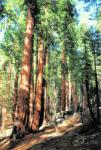Living with Fire – Reducing Wildfire Threat
Brush Build Up
 Due to excessive amounts of fuel that have built up in forest, woodlands, and rural subdivisions fire can no longer be allowed to perform its ecological role. Prior to the 1900’s, fires begun by lightning or indigenous residents periodically burned the forest and oak woodlands. These low intensity fires (an early version of vegetation management) cleared out small trees and shrubs, and dead or dying plants, reducing the amount of fuel present and making catastrophic fires very rare. Now local property owners need to take steps to create defensible space around their buildings by managing their vegetation.
Due to excessive amounts of fuel that have built up in forest, woodlands, and rural subdivisions fire can no longer be allowed to perform its ecological role. Prior to the 1900’s, fires begun by lightning or indigenous residents periodically burned the forest and oak woodlands. These low intensity fires (an early version of vegetation management) cleared out small trees and shrubs, and dead or dying plants, reducing the amount of fuel present and making catastrophic fires very rare. Now local property owners need to take steps to create defensible space around their buildings by managing their vegetation.
Defensible Space Law
California law previously required a 30-foot defensible space around all structures. This law has been revised to 100 feet on level parcels, and an even greater distance down slope on steep parcels. Tree spacing is critical. The distance between the branches of adjoining trees should be 10 feet on level areas and greater on steep areas. This will greatly reduce the chance of fire spreading by moving from the crown of one tree to the next. Planting trees where they will not grow into power lines or act as a path for fire to house roofs can also improve chances that a home will not be lost to wildfire.
Landscaping Defensible Space
Defensible space does not need to be bare. Green grass and other low growing, fire resistant plants should be planted to protect soils from erosion. Well maintained and irrigated turf, flower beds, and groundcover will offer less fuel for a wildfire than the native shrubs. Take a look at our Fire Resistant Landscaping section for some great tips.
